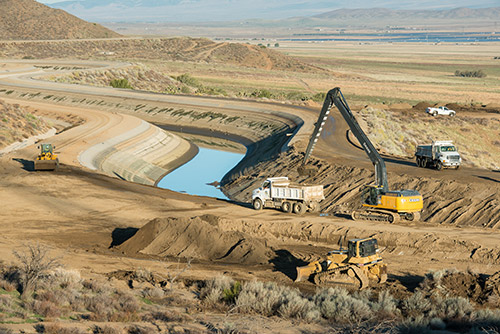Front Line: Water Supply Increasingly Affecting Location Decisions
Over the last few years, there has been a heightened focus on abundant access to water for companies seeking new locations.
Q2 2023

Water consumption was a major concern when Nevada officials assembled a $1.4 billion incentive package to entice Tesla to build its 1.9-million-square-foot (and growing) “gigafactory,” about 12 miles east of Reno. The Tahoe Reno Industrial Center, where the massive plant and several other large corporate facilities are located, has been serving tenants from groundwater wells. It also holds water rights for the nearby Truckee River, with rights being restricted during drought periods. Officials negotiated a solution in which the cities of Reno and Sparks agreed to transfer 4,000 acre-feet per year of treated wastewater to the complex.
Recent weather and climate trends have made water supply even more of a vital concern. For companies seeking new locations, over the last three to five years, water has become a heightened focus, says Larry Gigerich, executive managing director at Ginovus, an Indiana-based consulting firm. “Clients are asking more questions about it. They are also looking at it as it relates to their employees being in areas where water supply impacts both cost and quality of life.”
Laws to Manage Use and Supplies
For decades, states in the U.S. have had laws to manage groundwater use. But, with increasing urgency, they have been taking a more active role in managing groundwater supplies, especially in the southwestern U.S. “For example, Arizona has had a lot of growth and has water challenges, but at the same time, the Tucson region has done a fantastic job, with 50 years of having a strategy around water,” Gigerich says.
In some states, especially in the Western and Mountain States, where water rights are still a part of the law, companies can take ownership of their own, proprietary water supplies from underground aquifers. “We are seeing some private companies in particular that are acquiring water rights.” When doing that, “there are a whole host of things that need to be considered,” especially impact on area residents, Gigerich notes.
States in drought-prone regions — like California, Arizona, New Mexico, Nevada, and Utah — have had aquifer-recovery programs in place for years. In 2014, California heightened its efforts, passing the Sustainable Groundwater Management Act, to halt aquifer overdraft and manage levels of pumping and recharge.
With increasing urgency, states have been taking a more active role in managing groundwater supplies. Overall, the Gateway Water Management Authority (GWMA) — an agency made up of cities and agencies within the Gateway region of southeastern Los Angeles County serving more than two million people — “has been a success,” requiring agencies to work more closely together to develop solutions, says Tim Parker, a Sacramento-based hydrologist consultant, and a director of the National Groundwater Association. While it will take time to address complex water-related issues, California and other states have been putting more focus on the issue and strategizing to develop measures to better preserve and re-use water and replenish aquifers, Parker says.
In the drought-challenged state of Texas, partly due to legal complexities and competing interests, “not a lot has happened yet, but there is a lot being planned, “ says Steve Young, a project manager and hydrologist at Austin-based consulting firm INTERRA, Inc. Statewide, several large projects are under way to test the feasibility of aquifer storage and recovery processes. “The state is looking at where the hydrological conditions are good to make this happen.” One major focus is figuring out how to better capture and store the large amounts of water dumped by hurricanes and other storms, Young says.
Identifying Water-Related Issues
For companies seeking to identify water-related issues, Gigerich recommends three steps: First, look at the current situation, i.e., sources of water and how is it processed and generated from area rivers, aquifers, and mountain runoff. Second, consider the strategic plan for water going forward; different types pf technology can help gray water recycling, which is being seen in some places. And, third, Gigerich recommends that companies “do some modeling, including population growth and water consumption, based on expected growth for the next 30 to 50 years.”
Project Announcements
Australia-Based Aquatic Leisure Technologies Group Plans Opp, Alabama, Manufacturing Operations
12/11/2025
Teradyne Plans Wixom, Michigan, Robotics Operations
12/11/2025
Robinson Plans Altoona, Iowa, Manufacturing Operations
12/11/2025
BioTouch Expands Columbus, Georgia, Operations
12/11/2025
Natrion Plans Erie County, New York, Battery Components Operations
12/11/2025
Czech-Based GZ PrintPak Expands Mount Pleasant, Wisconsin, Manufacturing Operations
12/11/2025
Most Read
-
The Workforce Bottleneck in America’s Manufacturing Revival
Q4 2025
-
Rethinking Local Governments Through Consolidation and Choice
Q3 2025
-
First Person: Filter King’s Expansion Playbook
Q3 2025
-
Lead with Facts, Land the Deal
Q3 2025
-
How Canada Stays Competitive
Q3 2025
-
Investors Seek Shelter in Food-Focused Real Estate
Q3 2025
-
America’s Aerospace Reboot
Q3 2025


